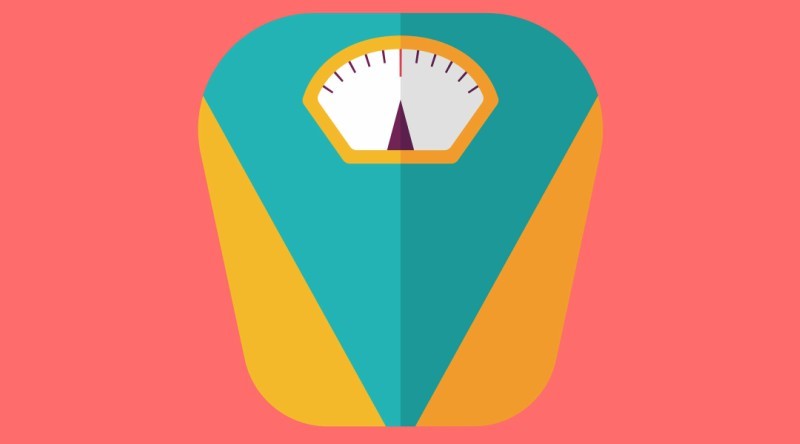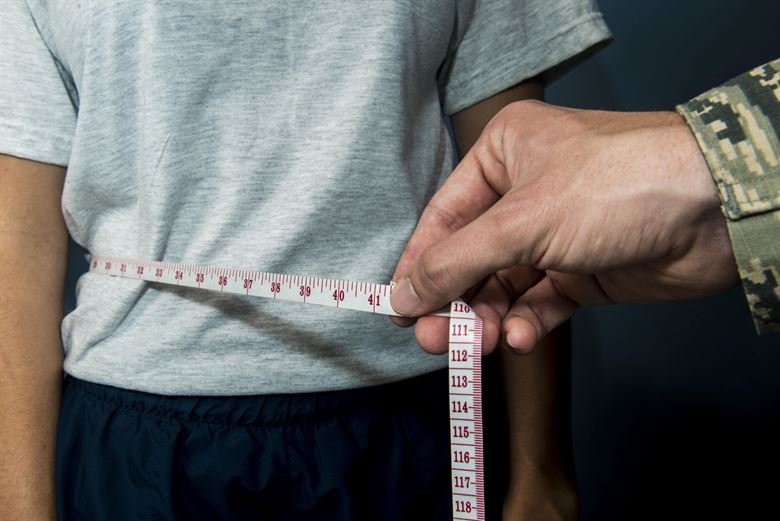Page Contents
by Jill Roberts

The Scale.
You wish you could look at it without emotion (it’s just another household object!) but it fills you with such a sense of dread.
You think:
What will the scale read today? Will it punish me for what I ate the other day? Will it reflect my efforts in the gym?
But before you put too much weight on your weight (pardon the pun), know that there are more accurate methods to evaluate your health. Grab the measuring tape!
To reach your ideal weight, don’t depend solely on the scale
Here’s why you shouldn’t measure yourself on what the scale reads: Scale doesn’t consider how much bone, muscle and fat your body has.
Consider this. Muscle is denser than fat. When building muscle, your weight can go up — even though you’re getting stronger and healthier! The scale can’t distinguish between weight from fat and weight from muscle.

Plus, even throughout the day, the scale can fluctuate based on:
- Your hydration level (whether you’re dehydrated or retaining water)
- Digestion and bowel movements (whether you’re fasting, have just eaten, if you have or haven’t eliminated waste recently)
- What you’re wearing
But don’t go holding a garage sale just yet. The scale is the measurement tool we can access the easiest. To best pinpoint your weight loss goals, first determine a healthy, realistic range for YOUR body. Then monitor the readings to see if you’re going in the right direction. Keep reading!
Body Mass Index: Universally Used but Antiquated
Body Mass Index (BMI) is a formula used to calculate a person’s body fat based on his or her ratio of weight to height. The heavier a person is for his or her height, the higher his or her BMI. Use this tool to calculate BMI.
- Below 18.5 is considered underweight
- 18.5 to 24.9 is considered normal
- 25 and above is deemed to be overweight
- 30 and above is considered obese
However, BMI has not found a very accurate indicator of health. For one, it doesn’t distinguish between sexes or ages. Second, it doesn’t take into account muscle mass, body shape or skeletal build.
For this reason, BMI might overestimate body fat in athletes (some are considered obese!) and may underestimate body fat in aging adults or people who have lost muscle. Averages can only go so far!
So could you be incorrectly categorized by your BMI? Sure. Still, it’s worth talking to your doctor. Studies have shown people with a high BMI are more at risk for certain preventable illnesses, such as type 2 diabetes and heart disease.
Waist circumference: Bigger waist = More Significant risk
Being overweight is one thing. But researchers have found that even people of a healthy weight are at risk for premature death. Why?
It’s all about body fat—and where it’s stored on your body.
A 10-year study found that normal-weight people with excess fat around their midsection have a higher mortality rate than people with smaller waists.

This type of excess fat is called visceral fat and is more dangerous because it is metabolically active. (Compare that to subcutaneous fat, which lies just below the skin in other parts of the body, and is more inert.) In fact, the study found that as waists grew by 2 inches, the risk of dying prematurely, increased by 17 percent for men and 13 percent for women.
Another study found that women with a waist size of 35 or higher had almost double the risk of dying from heart attack than women who reported a waist size of 28 inches or less.
To measure your waist: Find the top of your hip bone and the bottom of your ribs. Breathe normally. Place a tape measure between these points, wrap around your waist, and check the measurement.
To those apple and pear-shaped body types: just because you’re not “overweight” doesn’t mean you’re not at risk for health problems.
Body composition
Measuring your body composition probably paints the complete picture of the health of your weight.
The catch?
Body composition is not a do-it-yourself test. Body composition evaluations, which have varying levels of complexity and with varying margins of error, are usually administered by medical or fitness professionals — sometimes at a pretty penny.

What exactly is body composition?
Body composition is the relative proportion of lean mass (including bones, tissues, organs, and muscle) to fat (essential and non-essential) in the body. Essential fat is the amount of fat we need for normal physiological function. Generally, in males, essential fat makes up 3-5 percent of the body. It’s 10-13 percent in females.
Everything else is non-essential, or excess body fat.
Here are the classifications:
- A body fat percentage of 6-13% in males; 14-20% in females is considered an “athlete”
- A body fat percentage of 14-17% in males; 21-24% in females is considered “fit”
- A body fat percentage of 18-24% in males; 25-31% in females is considered “average”
- A body fat percentage of 25% and higher in males; 32% and higher in females is considered “obese”
That means a woman who weighs 190 pounds and has a body fat percentage of 30 percent is carrying 57 pounds of fat. If she loses 17 pounds (of fat), her body fat percentage drops to 23 percent. A lower body fat percentage, just like a lower BMI, generally means you’re at lower risk for specific conditions. Seem doable?
Remember, weight loss is not the only way to decrease your body fat percentage building lean muscle is another.
Clothing size
Perhaps the best indicator of all—how do your clothes fit?
Many people who may otherwise get discouraged by the scale rely on their clothes to tell them when they’d indulged a few times too many, and readjust.
Now that you have a much better idea of your ideal weight range, keep an eye on the fit of your clothes. For instance, take your favorite jeans.
While wearing them, see how many fingers you can fit in your waistband. Check again in a few weeks. If all of a sudden your pants won’t stay up, note the progress and reward yourself with a shopping trip!
At the very least, aim below these numbers: Men with a pants size of 38 or larger and women with a dress size of 16 or larger are at increased health risks.